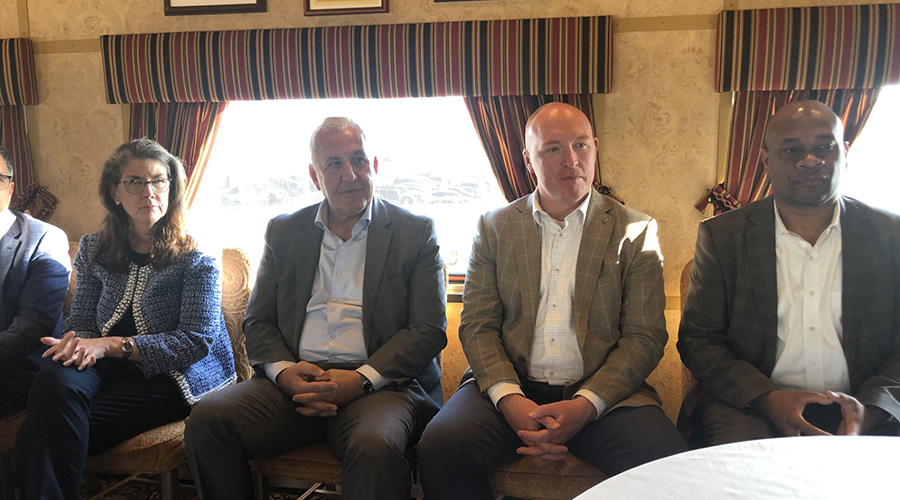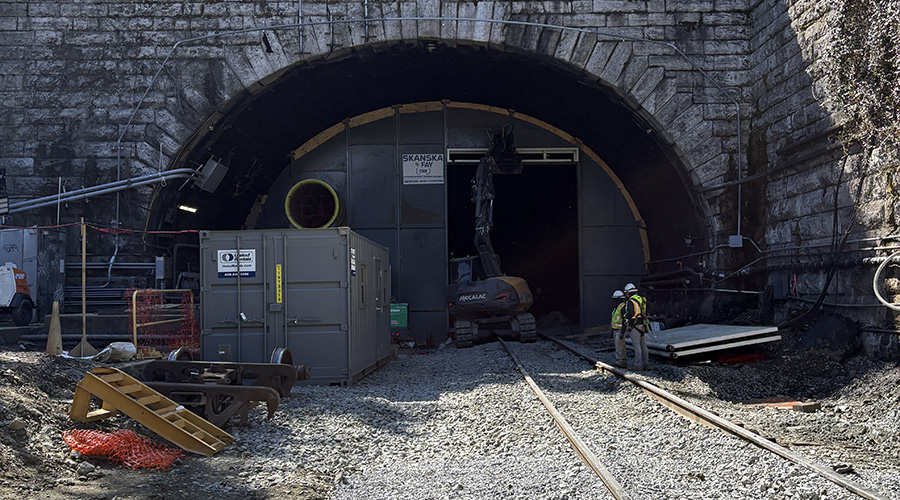Big discussions on hefty UP topics aboard the Big Boy steam train in Texas
10/14/2024
By Jeff Stagl, Managing Editor
At midday on Oct. 9, Union Pacific Railroad’s Heartland of America train pulled by the famed Big Boy steam locomotive pulled into West, Texas.
The stop was one of more than three dozen planned for the 2024 Heartland of America tour, which runs from Aug. 28 to Oct. 23 through areas of Arkansas, Colorado, Illinois, Iowa, Kansas, Missouri, Nebraska, Oklahoma, Texas and Wyoming.
Twenty-five Big Boys were built during World War II, but only eight of the units remain in existence. One of them — No. 4014 that pulls the Heartland of America train — is considered the world’s largest operating steam locomotive.
The steam train is highly popular with the public. For example, a stop in Rochelle, Illinois, south of Chicago on Sept. 9 drew more than 60,000 people.
The crowd that gathered in West, Texas, on Oct. 9 offered more proof about the tour’s mass appeal. Although the population of the town near Waco barely exceeds 2,500, hundreds of people lined track adjacent to a downtown grade crossing.
 Unassuming, approachable and affable, CEO Jim Vena says the progress UP has posted since he took the reins over a year ago is the result of a total team effort. Shown at left is UP Chief Communications Officer Clarissa Beyah. Jeff Stagl
Unassuming, approachable and affable, CEO Jim Vena says the progress UP has posted since he took the reins over a year ago is the result of a total team effort. Shown at left is UP Chief Communications Officer Clarissa Beyah. Jeff StaglUP’s senior management team — minus one member, Executive Vice President and Chief Financial Officer Jennifer Hamann — also were stationed near the crossing to greet the train. After it stopped, they climbed aboard for a Big Boy media trip that included six members of national trade publications that cover the rail industry and several Dallas news outlets.
The senior executive attendees were CEO Jim Vena; President Beth Whited; EVP of Operations Eric Gehringer; EVP and Chief Information Officer Rahul Jalali; EVP of Marketing and Sales Kenny Rocker; and Senior VP and Chief Human Resources Officer Josh Perkes.
Soon after boarding, the execs expressed pride about the outpouring of attention the tour was receiving. And not long after that, they made it clear they’re proud about something else: the encouraging results the company has been registering since Vena took over as the top exec about a year ago.
Not that Vena is taking all the credit. While chatting with the media members, he acknowledged the entire senior management team and UP’s employees for their roles in what’s been much more of a team effort.
 Senior executives who rode the media tour train included (from left) President Beth Whited, Vena, EVP of Operations Eric Gehringer and EVP of Marketing and Sales Kenny Rocker. Jeff Stagl
Senior executives who rode the media tour train included (from left) President Beth Whited, Vena, EVP of Operations Eric Gehringer and EVP of Marketing and Sales Kenny Rocker. Jeff StaglThe “there’s no ‘i’ in team” chatter suits the unassuming, approachable and affable Vena. He boarded the train holding a kolache, a Czech/Slovak sweet pastry with a portion of fruit surrounded by puffy yeast dough. He quickly pointed out to the media guests how he had received advice from some locals where to purchase the treat and why he bought more than one: to ensure everyone on board could share them.
Sharing is what the media trip was all about. During a range of mostly informal discussions paced intermittently over about a three-hour period, Vena and the other execs relayed a host of thoughts and comments on recent developments and company performance.
Vena led off the discussions, choosing to sit in a chair near the two tables manned by the media members to keep the dialogue more intimate and personal.
Since he took the railroad’s reins in August 2023 — much like the kolache on the train — Vena has tried to relish the experience. He came out of retirement to lead UP, which he characterizes as an iconic company with a very long, rich and successful history, but one that was struggling with operational and financial performance.
 Shown from far left: Chief Human Resources Officer Josh Perkes and Chief Information Officer Rahul Jalali, who also were part of the tour along with Whited, Vena and Gehringer. Jeff Stagl
Shown from far left: Chief Human Resources Officer Josh Perkes and Chief Information Officer Rahul Jalali, who also were part of the tour along with Whited, Vena and Gehringer. Jeff StaglVena since has tried to position the Class I as a railroad that’s more fitting to its pedigree — and more likely to result in better performance. What the railroad does matters because it plays a major role in the nation’s transportation landscape, he says.
“We move products that people use every day in their lives. That’s what’s cool about what we do,” says Vena.
But those products need to get where they’re going in a timely and reliable manner. That’s why high service performance remains one of the pillars of UP’s strategy, along with improved safety and continuous growth.
“We don’t want short-term profits, we want long-term profits,” says Vena. “We have a multiyear plan. If we do it as we’ve planned, we will succeed.”
For example, UP has created a buffer locomotive fleet with about 500 extra units. Those locomotives can be put into operation if something unexpected happens. And that did occur recently, when UP’s weekly intermodal volume shot up 35% in part because of the short labor strike at East Coast ports.
“We have truly proven the potential of our intermodal business,” says Vena. “People come to me and say, ‘Coal business continues to decline.’ But then I say, ‘So what?’ We need to control what we can control.”
Following Vena, these five senior executives shared updates and progress reports during a series of discussions.
Gehringer: UP continues to post progress with preventing serious injuries by stressing safety procedures and policies and incorporating more technologies. One technology — in the form of software — helps employees build trains that can safely operate from origin to destination in the most efficient manner possible under the guiding hand of a train crew. Called Precision Train Builder, it is designed to simulate trains and their operations over hundreds of miles of track to more accurately identify where to place rail cars within a train and how much motive power is required for the most efficient and safe operation. “It looks at all aspects of a train,” Gehringer says.
Whited: In her recent discussions with governors and other rail industry stakeholders, the primary aim is to find new ways their needs can align with UP’s interests, Whited says. For example, a chat with Wyoming Gov. Mark Gordon centered on displacing the ongoing decline of coal production in the Powder River Basin. One idea: Carbon sequestration, or the process of capturing and storing atmospheric carbon dioxide. Given its natural resources and infrastructure, Wyoming might be “the best place to capture carbon,” she says. Alternative options in other areas could be the production of biofuels or emerging chemicals.
Rocker: UP is striving to add crucial and lucrative infrastructure at lightning speeds. An intermodal terminal that opened in Phoenix in February was completed in just 45 days after the railroad’s initial announcement about the project. “The terminal in Phoenix was done in weeks, not months,” Rocker says. The facility now serves one of the fastest-growing U.S. markets, connecting points in the Southwest with the major ports in southern California. Last year, the railroad also quickly converted a pop-up terminal in Minnesota’s Twin Cities into a full terminal. Currently, UP is exploring the possibilities and requirements of serving more facilities in the Gulf Coast area, such as those that produce petrochemicals, plastics and caustic sodas. “We are looking at our assets over the next 20, 30 and 40 years,” he says.
Jalali: UP firmly remains on a path to become a technology-enabled company rather than a technology company, he said. A big part of that was the early 2024 cutover from a traditional transportation management computer system to a new modern NetControl system. “We are the first Class I that’s not on a mainframe system,” Jalali says. Using business logic and other software, NetControl processes everything from rail-car inventory and scheduling to waybill processing and train, locomotive and terminal management. It provides shipment tracking of every rail car within terminals and helps safely assign each car to a train as it advances to a destination. “We get rich, real-time data,” he says. UP plans to launch the first phase of a “Customer Vision” enhancement in December.
Perkes: UP’s employee retention rate has exceeded 90% over a six-year period. One reason: “We are actively listening to the voice of employees,” Perkes says. The railroad conducts a worker survey to help determine employees’ priorities and needs. In addition, efforts continue to improve training programs, tweak work rules and enhance labor agreements to retain and attract workers. “We want there to be a high quality of life for employees,” he says.
Soon after the steam train reached Fort Worth, the media tour concluded. Then, some UP employees began to arrive to view the train with their families. Employee tours continued on Oct. 10 followed by public viewings on Oct. 11.
After that, the Heartland of America train was headed to points in Oklahoma, Kansas and Colorado to cap off the tour. Big Boy then will be given a long rest at its permanent home in Cheyenne, Wyoming.
Although the senior team doesn’t plan to rest on any laurels, it’s OK to take a step back once in a while and hail some positives, including the warm reception to the Heartland of America train tour, says Vena.
“I’m very proud of where we are,” he says.


